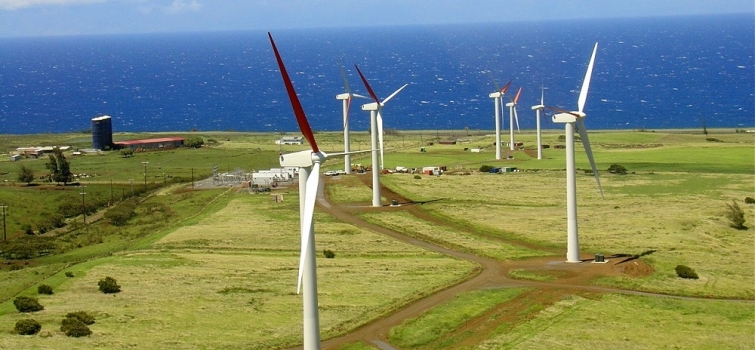
Wind turbines at Upolu Point, the northern tip of Hawaii. Photo credit: Hawaiian Electric Light Company, NREL 14697.
By Jeremy Williams
Climate change action is firmly off the agenda for America’s new Republican administration. Actually, that’s not true. It is on the agenda, but only to water down or remove any current commitments. Though they may change their minds at some point, for now, it looks like the US government is only going to make things worse for global climate change. Any hope for action is going to have to come elsewhere, at the state or city level, or through business.
So let’s do a quick tour of promising developments across the Atlantic because good things are happening if you look past the official denial at the government level.
Top of the list comes Hawaii. It’s the first state to make a commitment to 100% renewable energy, aiming to complete the transition by 2045. When the commitment was made, Hawaii had the highest fossil fuel dependency of any US state, so this was a big challenge. The reason for this dependency is that most electricity is generated in oil-fired power stations. This is strange for a region that has abundant solar capacity, wind power potential and geothermal, especially since Hawaii had the country’s highest energy prices. But better late than never.
Between 2002 and 2010, under the leadership of governor Linda Lingle, Hawaii created new incentives for solar power, banned new coal power, put solar hot water on all new homes, and adopted its clean energy target. Lingle was a Republican, by the way. Just last week a major new solar farm was opened in Hawaii, with enough storage capacity to use that solar power on a 24-hour basis. Local people will see their energy bills halved in the switch from diesel generators to solar. 12% of homes had solar panels by 2015, which was more than the substandard local grid could handle, but progress is being made. There’s even a bill in the works at the moment to transition all transport to renewable energy as well.
Here are a few others:
- Vermont has targets for 70% renewable energy by 2032.
- California’s energy plan calls for 50% clean energy by 2030, which it is on track to exceed. The state operates a cap and trade system, and a goal to reduce carbon by 30% on 1990 levels by 2030, the most ambitious carbon target in North America.
- New York State is also aiming for 50% renewable energy by 2o3o.
- Oregon is switching off coal power and aiming for 40% renewable energy by 2040.
Massachusetts is another leading state. It currently aims to reduce greenhouse gasses by 25% by 2020, but there’s a more radical proposal on the table – a bill is being considered at the moment that calls for a complete transition to renewable energy by 2050. That’s across all sectors, including electricity, transport, and heating. If it passes, Massachusetts will have set a new standard.
At the city level, a number of cities have 100% clean energy targets, including San Diego and Salt Lake City. And many high-profile American businesses have made similar promises, such as Google, Walmart, and Nike.
For a country the size of the USA, there could be more. It’s still much easier to talk about clean energy than climate change specifically. But there is good news to be found, communities setting an example, and a growing number of regions determined to set their own targets regardless of what the federal government does.
Originally posted on Make Wealth History.
Categories: climate change, energy
6 replies »